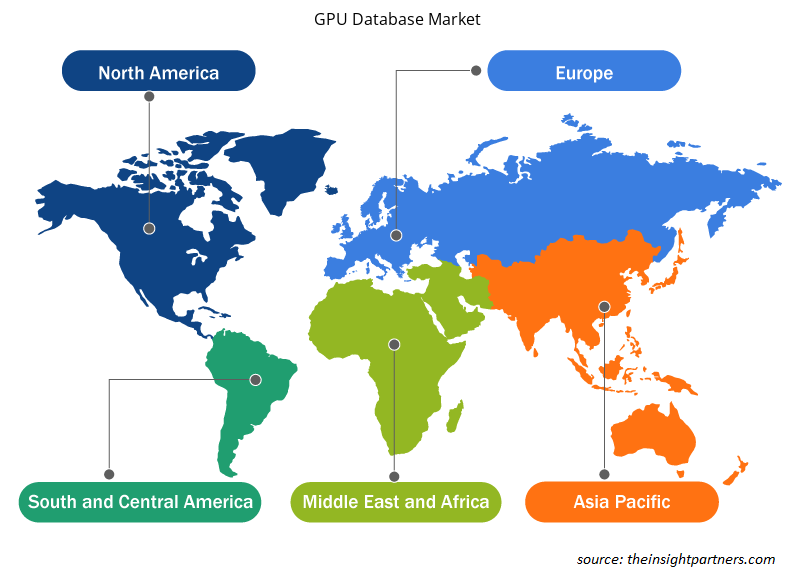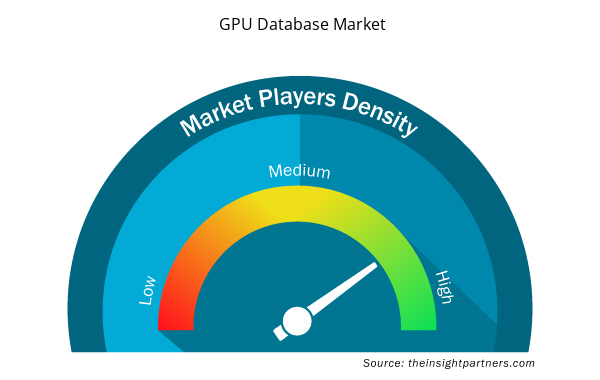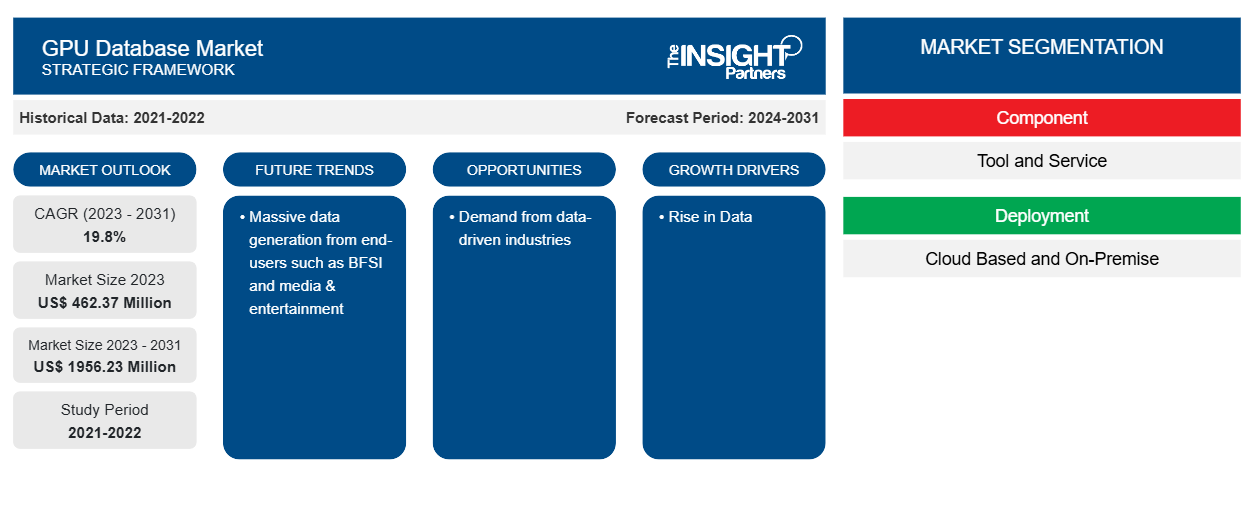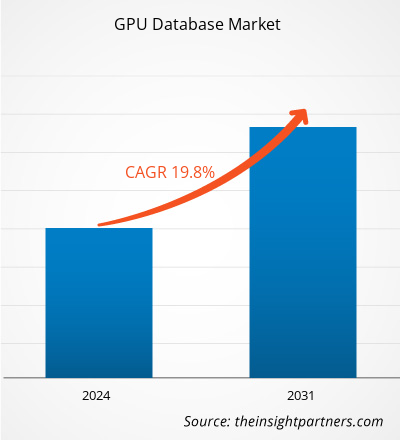Si prevede che la dimensione del mercato dei database GPU raggiungerà 1956,23 milioni di dollari entro il 2031, rispetto ai 462,37 milioni di dollari del 2023. Si prevede che il mercato registrerà un CAGR del 19,8% nel periodo 2023-2031. L'aumento dei dati e la crescita delle industrie basate sui dati rimarranno probabilmente tendenze chiave nel mercato.
Analisi di mercato del database GPU
Le crescenti industrie basate sui dati sono uno dei principali fattori trainanti del mercato dei database GPU. L'aumento della digitalizzazione e l'inclinazione delle aziende verso soluzioni per elaborare grandi set di dati stanno alimentando la crescita del mercato. Il database GPU trova la sua applicazione in alcune delle tecnologie emergenti come l'intelligenza artificiale, l'apprendimento automatico e profondo, l'Internet of Things (IoT) e l'analisi geospaziale, che crea enormi opportunità per la crescita del mercato dei database GPU.
Panoramica del mercato dei database GPU
Un database GPU utilizza unità di elaborazione grafica (GPU) per eseguire operazioni di database. Una GPU è un processore programmabile progettato per eseguire rapidamente il rendering di immagini e video ad alta risoluzione. Il database GPU elabora enormi volumi di dati in modo più rapido ed efficace rispetto alle CPU perché operano in parallelo anziché in sequenza. Pertanto, i database GPU sono in genere più veloci e orientati all'analisi, che è più flessibile nell'elaborazione di molti tipi diversi di dati o di quantità di dati molto più grandi.
Personalizza questo report in base alle tue esigenze
Riceverai la personalizzazione gratuita di qualsiasi report, comprese parti di questo report, o analisi a livello nazionale, pacchetto dati Excel, oltre a usufruire di grandi offerte e sconti per start-up e università
- Scopri le principali tendenze di mercato in questo rapporto.Questo campione GRATUITO includerà analisi di dati che spaziano dalle tendenze di mercato alle stime e alle previsioni.
Driver e opportunità del mercato dei database GPU
Aumento dei dati a favore del mercato
Con l'avvento della digitalizzazione, i dati vengono generati a una velocità incredibile. I dati di varie varietà, volumi e velocità devono essere analizzati ed elaborati per realizzare qualsiasi schema nascosto e approfondimento con l'aiuto di tecniche di analisi dei dati . L'analisi tradizionale non riesce a fornire tecniche e tecnologie di analisi ottimali. Ciò genera la necessità di un database GPU. Con capacità di elaborazione parallela massiva, il database GPU fornisce in modo conveniente un'elaborazione ad alte prestazioni. Il database GPU è una soluzione ideale per gestire grandi set di dati, il che determina la domanda di questa tecnologia.
Domanda da parte dei settori basati sui dati.
I dati GPU hanno un'elevata potenza di calcolo. Grazie alle loro capacità di elaborazione parallela, possono elaborare dati fino a 100 volte più velocemente rispetto alle configurazioni contenenti solo CPU, come illustrato. Pertanto, vari settori basati sui dati come BFSI, media e intrattenimento e altri richiedono soluzioni per carichi di lavoro ad alta intensità di elaborazione per applicazioni di analisi dei dati, il che determina la domanda di database GPU. Gli operatori di mercato stanno lanciando soluzioni per soddisfare questa domanda. Graphistry ha lanciato Hub Pro (Graphistry Hub for Professionals) per offrire ai clienti l'analisi grafica visiva accelerata da GPU. Graphistry Hub Pro risolve i problemi di sicurezza, prezzi e manutenzione per gli individui e le prossime Hub Organizations per i team. (Fonte: Graphistry, comunicato stampa, settembre 2021)CPUs, as illustrated. Thus, various data-driven industries such as BFSI, media & entertainment, and others demand solutions to processing-intensive workloads for data analytics applications, which drives the demand for GPU databases. The market players are launching solutions to cater to this demand. Graphistry launched Hub Pro (Graphistry Hub for Professionals) to bring GPU-accelerated visual graph analysis to customers. Graphistry Hub Pro solves security, pricing, and maintenance for individuals, and the upcoming Hub Organizations for teams. (Source: Graphistry, Press Release, September 2021)
Analisi della segmentazione del rapporto di mercato del database GPU
I segmenti chiave che hanno contribuito alla derivazione dell'analisi di mercato del database GPU sono componenti, distribuzione, applicazione e settore verticale.
- In base al componente, il mercato dei database GPU è diviso in strumenti e servizi. Il segmento degli strumenti ha detenuto la quota maggiore del mercato nel 2023.
- Per distribuzione, il mercato è segmentato in cloud based e on-premise. Si prevede che il cloud based crescerà con il CAGR più elevato.CAGR.
- Per applicazione, il mercato è segmentato in rilevamento e prevenzione delle frodi, governance risk & compliance (GRC), gestione dell'esperienza del cliente, manutenzione predittiva, gestione della supply chain, threat intelligence e altri. La gestione dell'esperienza del cliente ha detenuto una quota significativa del mercato nel 2023.GRC), customer experience management, predictive maintenance, supply chain management, threat intelligence, and others. The customer experience management held a significant share of the market in 2023.
- Per settore verticale, il mercato è segmentato in BFSI, IT e telecomunicazioni, vendita al dettaglio ed e-commerce, sanità, trasporti e logistica, governo e difesa e altri. Il BFSI ha detenuto una quota significativa del mercato nel 2023.BFSI, IT & telecom, retail & e-commerce, healthcare, transportation & logistics, government & defense, and others. The BFSI held a significant share of the market in 2023.
Analisi della quota di mercato del database GPU per area geografica
L'ambito geografico del rapporto di mercato sui database GPU è suddiviso principalmente in cinque regioni: Nord America, Asia Pacifico, Europa, Medio Oriente e Africa, Sud e Centro America.
Si prevede che la regione Asia-Pacifico crescerà con il CAGR più elevato. L'aumento della digitalizzazione e la crescente domanda di tecniche avanzate di analisi dei dati nelle economie in via di sviluppo come India e Cina stanno guidando la crescita del mercato nella regione. La trasformazione digitale in settori basati sui dati come BFSI, sanità, produzione e altri, guida ulteriormente la crescita del mercato. La crescente domanda di estrazione di informazioni da grandi set di dati sta alimentando la crescita del mercato in Asia-Pacifico.CAGR. The rise in digitalization and growing demand for advanced data analytics techniques in developing economies such as India and China is driving market growth in the region. Digital transformation across data-driven industries such as BFSI, healthcare, manufacturing, and others, further drives market growth. The increasing demand for extracting insights from large datasets is fuelling the market growth in Asia Pacific.
Approfondimenti regionali sul mercato dei database GPU
Le tendenze regionali e i fattori che influenzano il mercato dei database GPU durante il periodo di previsione sono stati ampiamente spiegati dagli analisti di Insight Partners. Questa sezione discute anche i segmenti e la geografia del mercato dei database GPU in Nord America, Europa, Asia Pacifico, Medio Oriente e Africa e America meridionale e centrale.

- Ottieni i dati specifici regionali per il mercato dei database GPU
Ambito del rapporto di mercato del database GPU
| Attributo del report | Dettagli |
|---|---|
| Dimensioni del mercato nel 2023 | 462,37 milioni di dollari USA |
| Dimensioni del mercato entro il 2031 | 1956,23 milioni di dollari USA |
| CAGR globale (2023-2031) | 19,8% |
| Dati storici | 2021-2022 |
| Periodo di previsione | 2024-2031 |
| Segmenti coperti | Per componente
|
| Regioni e Paesi coperti | America del Nord
|
| Leader di mercato e profili aziendali chiave |
|
Densità dei giocatori del mercato del database GPU: comprendere il suo impatto sulle dinamiche aziendali
Il mercato del database GPU sta crescendo rapidamente, spinto dalla crescente domanda degli utenti finali dovuta a fattori quali l'evoluzione delle preferenze dei consumatori, i progressi tecnologici e una maggiore consapevolezza dei vantaggi del prodotto. Con l'aumento della domanda, le aziende stanno ampliando le loro offerte, innovando per soddisfare le esigenze dei consumatori e capitalizzando sulle tendenze emergenti, il che alimenta ulteriormente la crescita del mercato.
La densità degli operatori di mercato si riferisce alla distribuzione di aziende o società che operano in un particolare mercato o settore. Indica quanti concorrenti (operatori di mercato) sono presenti in un dato spazio di mercato in relazione alle sue dimensioni o al valore di mercato totale.
Le principali aziende che operano nel mercato dei database GPU sono:
- BRYTLYT
- GRAFISTERIA
- H2O.ai
- Giusto
- Kinetica DB Inc.
- Neo4J, INC.
Disclaimer : le aziende elencate sopra non sono classificate secondo un ordine particolare.

- Ottieni la panoramica dei principali attori del mercato del database GPU
Notizie di mercato e sviluppi recenti del database GPU
Il mercato dei database GPU viene valutato raccogliendo dati qualitativi e quantitativi dopo la ricerca primaria e secondaria, che include importanti pubblicazioni aziendali, dati associativi e database. Di seguito sono elencati alcuni degli sviluppi nel mercato dei database GPU:
- NVIDIA e HP Inc. hanno annunciato l'integrazione delle librerie di elaborazione dati NVIDIA CUDA-X con le soluzioni workstation HP AI per potenziare il lavoro di preparazione ed elaborazione dati che costituisce la base dello sviluppo di AI generativa. Basate sulla piattaforma di elaborazione NVIDIA CUDA, le librerie CUDA-X velocizzano l'elaborazione dati per un'ampia gamma di tipi di dati, tra cui tabelle, testo, immagini e video. Includono la libreria NVIDIA RAPIDS cuDF, che accelera il lavoro di quasi 10 milioni di data scientist che utilizzano il software pandas fino a 110 volte utilizzando una GPU NVIDIA RTX 6000 Ada Generation anziché un sistema solo CPU, senza richiedere alcuna modifica al codice. (Fonte: NVIDIA, comunicato stampa, marzo 2024)
- Zilliz, pioniere nella tecnologia dei database vettoriali , ha annunciato il rilascio di Milvus 2.4, stabilendo un nuovo standard nelle capacità di ricerca vettoriale con una rivoluzionaria funzionalità di indicizzazione GPU basata su CUDA-Accelerated Graph Index for Vector Retrieval (CAGRA) di NVIDIA, parte della libreria RAPIDS cuVS. (Fonte: Zilliz, comunicato stampa, marzo 2024)
Copertura e risultati del rapporto sul mercato dei database GPU
Il rapporto "Dimensioni e previsioni del mercato del database GPU (2021-2031)" fornisce un'analisi dettagliata del mercato che copre le seguenti aree:
- Dimensioni e previsioni del mercato dei database GPU a livello globale, regionale e nazionale per tutti i segmenti di mercato chiave coperti dall'ambito
- Tendenze del mercato del database GPU e dinamiche di mercato come driver, vincoli e opportunità chiave
- Analisi dettagliata delle cinque forze PEST/Porter e SWOT
- Analisi di mercato del database GPU che copre le principali tendenze del mercato, il quadro globale e regionale, i principali attori, le normative e i recenti sviluppi del mercato
- Analisi del panorama industriale e della concorrenza che copre la concentrazione del mercato, l'analisi della mappa di calore, i principali attori e gli sviluppi recenti per il mercato dei database GPU
- Profili aziendali dettagliati
- Analisi storica (2 anni), anno base, previsione (7 anni) con CAGR
- Analisi PEST e SWOT
- Valore/volume delle dimensioni del mercato - Globale, regionale, nazionale
- Industria e panorama competitivo
- Set di dati Excel



Report Coverage
Revenue forecast, Company Analysis, Industry landscape, Growth factors, and Trends

Segment Covered
This text is related
to segments covered.

Regional Scope
North America, Europe, Asia Pacific, Middle East & Africa, South & Central America

Country Scope
This text is related
to country scope.
Domande frequenti
The estimated value of the GPU database market will be US$ 1956.23 million by 2031.
BRYTLYT; GRAPHISTRY; H2O.ai; Jedox; Kinetica DB Inc.; Neo4J, INC.; SQREAM DB; ZILLIZ ; HEAVY.AI; and NVIDIA CORPORATION are some of the key players operating in the GPU database market.
Massive data generation from end-users such as BFSI and media & entertainment is considered a key trend in the GPU database market.
The rise in data and the growing data-driven industries are the key driving factors impacting the GPU database market.
The global GPU database market is estimated to register a CAGR of 19.8% during the forecast period 2023–2031.
Trends and growth analysis reports related to Technology, Media and Telecommunications : READ MORE..
The Insight Partners performs research in 4 major stages: Data Collection & Secondary Research, Primary Research, Data Analysis and Data Triangulation & Final Review.
- Data Collection and Secondary Research:
As a market research and consulting firm operating from a decade, we have published and advised several client across the globe. First step for any study will start with an assessment of currently available data and insights from existing reports. Further, historical and current market information is collected from Investor Presentations, Annual Reports, SEC Filings, etc., and other information related to company’s performance and market positioning are gathered from Paid Databases (Factiva, Hoovers, and Reuters) and various other publications available in public domain.
Several associations trade associates, technical forums, institutes, societies and organization are accessed to gain technical as well as market related insights through their publications such as research papers, blogs and press releases related to the studies are referred to get cues about the market. Further, white papers, journals, magazines, and other news articles published in last 3 years are scrutinized and analyzed to understand the current market trends.
- Primary Research:
The primarily interview analysis comprise of data obtained from industry participants interview and answers to survey questions gathered by in-house primary team.
For primary research, interviews are conducted with industry experts/CEOs/Marketing Managers/VPs/Subject Matter Experts from both demand and supply side to get a 360-degree view of the market. The primary team conducts several interviews based on the complexity of the markets to understand the various market trends and dynamics which makes research more credible and precise.
A typical research interview fulfils the following functions:
- Provides first-hand information on the market size, market trends, growth trends, competitive landscape, and outlook
- Validates and strengthens in-house secondary research findings
- Develops the analysis team’s expertise and market understanding
Primary research involves email interactions and telephone interviews for each market, category, segment, and sub-segment across geographies. The participants who typically take part in such a process include, but are not limited to:
- Industry participants: VPs, business development managers, market intelligence managers and national sales managers
- Outside experts: Valuation experts, research analysts and key opinion leaders specializing in the electronics and semiconductor industry.
Below is the breakup of our primary respondents by company, designation, and region:

Once we receive the confirmation from primary research sources or primary respondents, we finalize the base year market estimation and forecast the data as per the macroeconomic and microeconomic factors assessed during data collection.
- Data Analysis:
Once data is validated through both secondary as well as primary respondents, we finalize the market estimations by hypothesis formulation and factor analysis at regional and country level.
- Macro-Economic Factor Analysis:
We analyse macroeconomic indicators such the gross domestic product (GDP), increase in the demand for goods and services across industries, technological advancement, regional economic growth, governmental policies, the influence of COVID-19, PEST analysis, and other aspects. This analysis aids in setting benchmarks for various nations/regions and approximating market splits. Additionally, the general trend of the aforementioned components aid in determining the market's development possibilities.
- Country Level Data:
Various factors that are especially aligned to the country are taken into account to determine the market size for a certain area and country, including the presence of vendors, such as headquarters and offices, the country's GDP, demand patterns, and industry growth. To comprehend the market dynamics for the nation, a number of growth variables, inhibitors, application areas, and current market trends are researched. The aforementioned elements aid in determining the country's overall market's growth potential.
- Company Profile:
The “Table of Contents” is formulated by listing and analyzing more than 25 - 30 companies operating in the market ecosystem across geographies. However, we profile only 10 companies as a standard practice in our syndicate reports. These 10 companies comprise leading, emerging, and regional players. Nonetheless, our analysis is not restricted to the 10 listed companies, we also analyze other companies present in the market to develop a holistic view and understand the prevailing trends. The “Company Profiles” section in the report covers key facts, business description, products & services, financial information, SWOT analysis, and key developments. The financial information presented is extracted from the annual reports and official documents of the publicly listed companies. Upon collecting the information for the sections of respective companies, we verify them via various primary sources and then compile the data in respective company profiles. The company level information helps us in deriving the base number as well as in forecasting the market size.
- Developing Base Number:
Aggregation of sales statistics (2020-2022) and macro-economic factor, and other secondary and primary research insights are utilized to arrive at base number and related market shares for 2022. The data gaps are identified in this step and relevant market data is analyzed, collected from paid primary interviews or databases. On finalizing the base year market size, forecasts are developed on the basis of macro-economic, industry and market growth factors and company level analysis.
- Data Triangulation and Final Review:
The market findings and base year market size calculations are validated from supply as well as demand side. Demand side validations are based on macro-economic factor analysis and benchmarks for respective regions and countries. In case of supply side validations, revenues of major companies are estimated (in case not available) based on industry benchmark, approximate number of employees, product portfolio, and primary interviews revenues are gathered. Further revenue from target product/service segment is assessed to avoid overshooting of market statistics. In case of heavy deviations between supply and demand side values, all thes steps are repeated to achieve synchronization.
We follow an iterative model, wherein we share our research findings with Subject Matter Experts (SME’s) and Key Opinion Leaders (KOLs) until consensus view of the market is not formulated – this model negates any drastic deviation in the opinions of experts. Only validated and universally acceptable research findings are quoted in our reports.
We have important check points that we use to validate our research findings – which we call – data triangulation, where we validate the information, we generate from secondary sources with primary interviews and then we re-validate with our internal data bases and Subject matter experts. This comprehensive model enables us to deliver high quality, reliable data in shortest possible time.


 Ottieni un campione gratuito per questo repot
Ottieni un campione gratuito per questo repot